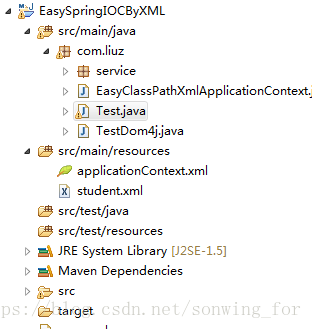首先我们回忆一下在我们学习spring或者在我们做项目的时候,肯定都用过基于xml配置bean的方式来配置bean,然后在dao层获取sessionFactory、在service层/biz层获取dao对象、在action层、controller层获取service对象。用的时候都知道在xml里面配置一下bean,给它id和class,在需要注入的bean下面配置上property。那么spring是怎么去帮你创建对象的呢?
看下面代码之前我们先来说说原理:
我们的web项目在启动的时候就会去读取spring的配置文件applicationContext.xml,使用类似于dom4j工具将xml里面的内容读取到java代码里面来,然后根据你传递过来的bean的id和xml里面的bean的id进行匹配,如果发现有,就会把创建的对象传递给你。当然了,我们都知道Spring的bean的作用域常用的有两种,一种是Prototype,一种是Singleton。
Prototype:原型模式,容器初始化的时候并不会创建bean对象,而在getBean的时候创建, 如果多次getBean,则会创建多个bean对象。
Singleton:单例模式,
lazy-init为false(默认是false,所以可以不用设置),则 ApplicationContext启动的时候就实例化该Bean,并且将实例化的Bean放在一个map结构的缓存中,下次再使用该Bean的时候, 直接从这个缓存中取
lazy-init为true,则该Bean的实例化是在第一次使用该Bean的时候进行实例化
下面这个例子就是基于原型模式实现的。
新建一个maven项目

maven依赖的包
<dependencies>
<!-- 引入Spring-AOP等相关Jar -->
<dependency>
<groupId>org.springframework</groupId>
<artifactId>spring-core</artifactId>
<version>3.0.6.RELEASE</version>
</dependency>
<dependency>
<groupId>org.springframework</groupId>
<artifactId>spring-context</artifactId>
<version>3.0.6.RELEASE</version>
</dependency>
<dependency>
<groupId>org.springframework</groupId>
<artifactId>spring-aop</artifactId>
<version>3.0.6.RELEASE</version>
</dependency>
<dependency>
<groupId>org.springframework</groupId>
<artifactId>spring-orm</artifactId>
<version>3.0.6.RELEASE</version>
</dependency>
<dependency>
<groupId>org.aspectj</groupId>
<artifactId>aspectjrt</artifactId>
<version>1.6.1</version>
</dependency>
<dependency>
<groupId>aspectj</groupId>
<artifactId>aspectjweaver</artifactId>
<version>1.5.3</version>
</dependency>
<dependency>
<groupId>cglib</groupId>
<artifactId>cglib</artifactId>
<version>2.1_2</version>
</dependency>
<!-- https://mvnrepository.com/artifact/com.mchange/c3p0 -->
<dependency>
<groupId>com.mchange</groupId>
<artifactId>c3p0</artifactId>
<version>0.9.5.2</version>
</dependency>
<!-- https://mvnrepository.com/artifact/mysql/mysql-connector-java -->
<dependency>
<groupId>mysql</groupId>
<artifactId>mysql-connector-java</artifactId>
<version>5.1.37</version>
</dependency>
<!-- https://mvnrepository.com/artifact/dom4j/dom4j -->
<dependency>
<groupId>dom4j</groupId>
<artifactId>dom4j</artifactId>
<version>1.6.1</version>
</dependency>
<!-- https://mvnrepository.com/artifact/commons-lang/commons-lang -->
<dependency>
<groupId>commons-lang</groupId>
<artifactId>commons-lang</artifactId>
<version>2.6</version>
</dependency>
</dependencies>
接口的定义:
public interface UserService {
public void add();
public String update();
}
接口的实现类
public class UserServiceImpl implements UserService {
public void add() {
System.out.println("执行了add方法");
}
public String update() {
System.out.println("执行了update方法");
return "abcd";
}
}
自定义的ClassPathXmlApplicationContext.class
import java.io.InputStream;
import java.util.List;
import org.apache.commons.lang.StringUtils;
import org.dom4j.Document;
import org.dom4j.DocumentException;
import org.dom4j.Element;
import org.dom4j.io.SAXReader;
/**
* 手写Spring IoC xml获取bean方式
* @author liuz
*
*/
public class EasyClassPathXmlApplicationContext {
private String xmlPath;
public EasyClassPathXmlApplicationContext(String xmlPath) {
this.xmlPath=xmlPath;
}
public Object getBean(String beanId) throws Exception{
//解析xml 获取所有的bean节点信息
if(beanId.equals("")||StringUtils.isEmpty(beanId)){
throw new Exception("beanId不能为空!");
}
List<Element> readXML=readXML();
if(readXML==null||readXML.isEmpty()){
throw new Exception("xml中未配置bean!");
}
String className=findByElementClass(readXML,beanId);
if(StringUtils.isEmpty(className)){
throw new Exception("该bean对象没有配置class");
}
//3.获取class信息,使用反射初始化
return newInstance(className);
}
/**
* 读取xml里面的节点 使用xml文件中bean的id跟传递过俩的id进行比较
* @param readXML
* @param beanId
* @return class 地址
* @throws Exception
*/
public String findByElementClass(List<Element> readXML,String beanId) throws Exception{
for(Element element:readXML){
//获取属性信息
String xmlBeanId=element.attributeValue("id");
if(StringUtils.isEmpty(xmlBeanId)){
throw new Exception("为获取到bean节点信息");
}
if(xmlBeanId.equals(beanId)){
String xmlClass=element.attributeValue("class");
return xmlClass;
//return newInstance(xmlClass);
}
}
return null;
}
public Object newInstance(String className) throws ClassNotFoundException,
InstantiationException, IllegalAccessException{
Class<?> classInfo=Class.forName(className);
return classInfo.newInstance();
}
/**
* 解析xml
* @throws DocumentException
*/
@SuppressWarnings("unchecked")
public List<Element> readXML() throws DocumentException{
SAXReader saxReader = new SAXReader();
//1.解析xml文件
Document document = saxReader.read(getResourceAsStream(xmlPath));
//读取跟节点
Element rootElement = document.getRootElement();
// 获取下面的子节点
List<Element> elements=rootElement.elements();
return elements;
}
/**
* 获取当前上下文路径
* @param xmlPath
* @return
*/
public InputStream getResourceAsStream(String xmlPath) {
return this.getClass().getClassLoader().getResourceAsStream(xmlPath);
}
}
测试类:
public class Test {
public static void main(String[] args){
EasyClassPathXmlApplicationContext app = new EasyClassPathXmlApplicationContext(
"applicationContext.xml");
UserService userService;
try {
userService = (UserService)app.getBean("userService");
userService.add();
userService.update();
} catch (Exception e) {
// TODO Auto-generated catch block
e.printStackTrace();
}
}
}
运行效果:

源代码下载地址:
链接:https://pan.baidu.com/s/1VsDeLWnHDRtJ4ogITGkMZg 密码:f3i4
具体的实现过程如果看不懂也可以去看余胜军老师的视频。










 本文通过手写简易版 Spring IoC 容器,详细介绍了如何基于 XML 配置文件解析 Bean 并实例化对象的过程。从 Maven 项目的搭建到自定义 ClassPathXmlApplicationContext 类的实现,再到最终的测试验证。
本文通过手写简易版 Spring IoC 容器,详细介绍了如何基于 XML 配置文件解析 Bean 并实例化对象的过程。从 Maven 项目的搭建到自定义 ClassPathXmlApplicationContext 类的实现,再到最终的测试验证。

















 866
866

 被折叠的 条评论
为什么被折叠?
被折叠的 条评论
为什么被折叠?










